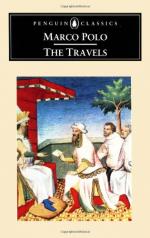Wadding gives a letter from the Pope (Alex. II.) under date 3rd Sept. 1329, addressed to the Emperor of Ethiopia, to inform him of the appointment of a Bishop of Diagorgan. As this place is the capital of a district near Tabriz (Dehi-Khorkhan) the papal geography looks a little hazy.
NOTE 2.—The allegation against the Abyssinian Christians, sometimes extended to the whole Jacobite Church, that they accompanied the rite of Baptism by branding with a hot iron on the face, is pretty old and persistent.
The letter quoted from Matt. Paris in the preceding note relates of the Jacobite Christians “who occupy the kingdoms between Nubia and India,” that some of them brand the foreheads of their children before Baptism with a hot iron (p. 302). A quaint Low-German account of the East, in a MS. of the 14th century, tells of the Christians of India that when a Bishop ordains a priest he fires him with a sharp and hot iron from the forehead down the nose, and the scar of this wound abides till the day of his death. And this they do for a token that the Holy Ghost came on the Apostles with fire. Frescobaldi says those called the Christians of the Girdle were the sect which baptized by branding on the head and temples. Clavijo says there is such a sect among the Christians of India, but they are despised by the rest. Barbosa, speaking of the Abyssinians, has this passage: “According to what is said, their baptism is threefold, viz., by blood, by fire, and by water. For they use circumcision like the Jews, they brand on the forehead with a hot iron, and they baptize with water like Catholic Christians.” The respectable Pierre Belon speaks of the Christians of Prester John, called Abyssinians, as baptized with fire and branded in three places, i.e. between the eyes and on either cheek. Linschoten repeats the like, and one of his plates is entitled Habitus Abissinorum quibus loco Baptismatis frons inuritur. Ariosto, referring to the Emperor of Ethiopia, has:—
“Gli e, s’ io non piglio
errore, in questo loco
Ove al baltesimo loro usano il fuoco.”
As late as 1819 the traveller Dupre published the same statement about the Jacobites generally. And so sober and learned a man as Assemani, himself an Oriental, says: “Aethiopes vero, seu Abissini, praeter circumcisionem adhibent etiam ferrum candens, quo pueris notam inurunt.”
Yet Ludolf’s Abyssinian friend, Abba Gregory, denied that there was any such practice among them. Ludolf says it is the custom of various African tribes, both Pagan and Mussulman, to cauterize their children in the veins of the temples, in order to inure them against colds, and that this, being practised by some Abyssinians, was taken for a religious rite. In spite of the terms “Pagan and Mussulman,” I suspect that Herodotus was the authority for this practice. He states that many of the nomad Libyans, when their children reached the age of four, used to burn the veins at the top of the head with a flock of wool; others burned the veins about the temples. And this they did, he says, to prevent their being troubled with rheum in after life.




